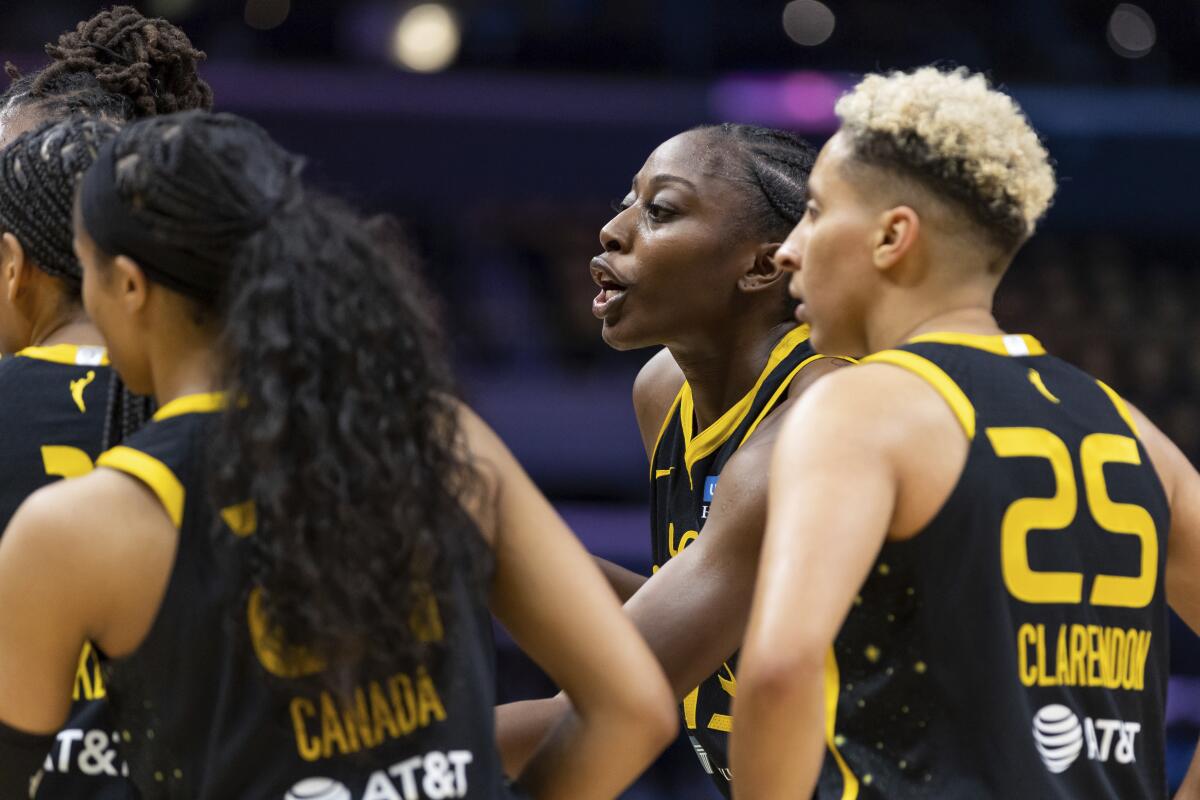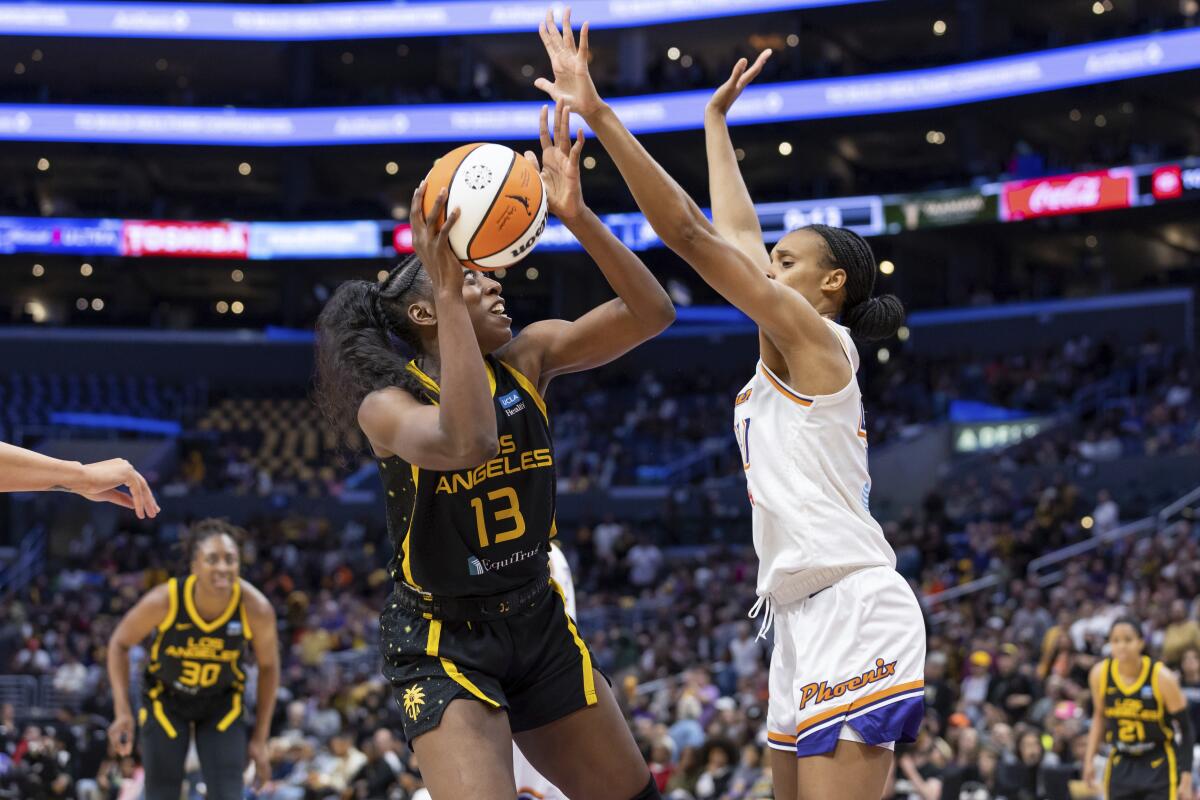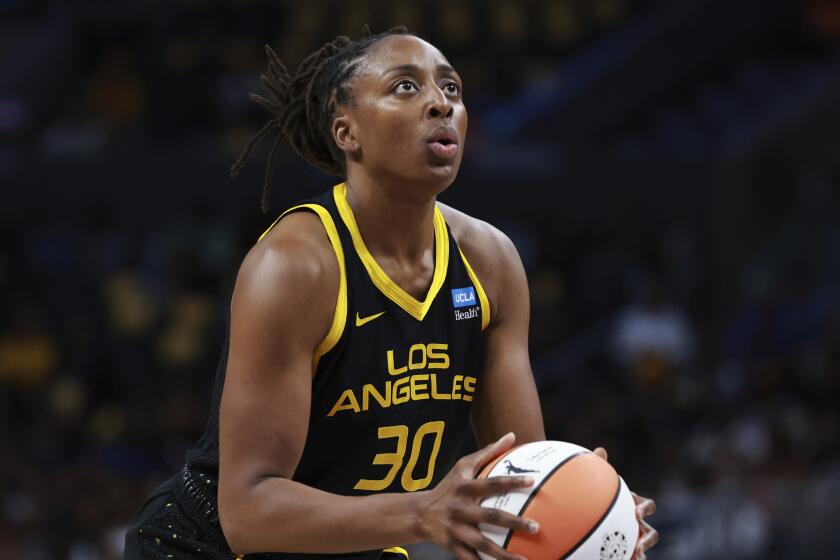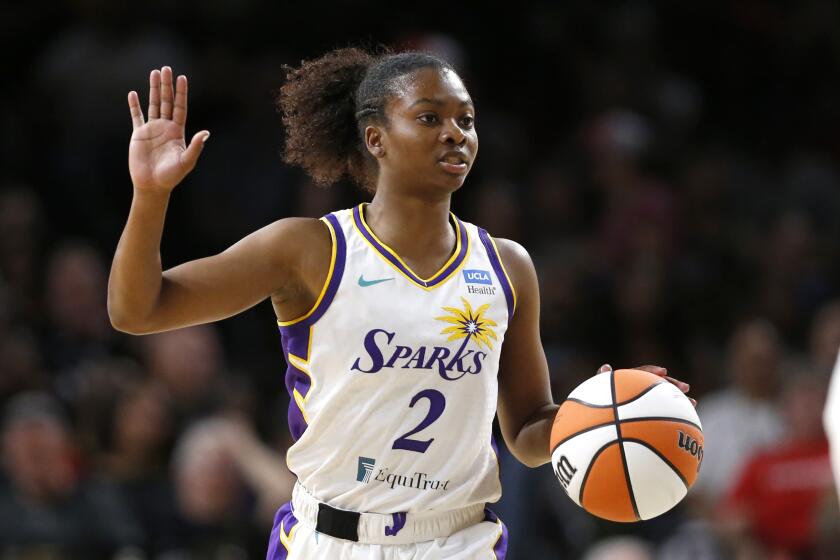WNBA’s expanded charter flights are a ‘game-changer.’ What’s next?

- Share via
On Saturday morning, after playing a road game the night before, Chiney Ogwumike woke up in her bed at home. It was bliss.
Until the Sparks forward considered that the opportunity to travel immediately after a game via charter flight like the one she hopped on Friday night in Phoenix was a fleeting perk.
“It makes a whole difference,” Ogwumike said. “The charter was nice. But it was like almost — do you want that at all? [To] touch the goodness? But it’s necessary.”
The Sparks were the first beneficiaries of the WNBA’s new charter flight policy, getting a private flight after an overtime win in Phoenix on Friday night, then sweeping the difficult back-to-back set with a 92-85 win over the Seattle Storm at Crypto.com Arena on Saturday. But as the league expands its charter flights slowly — adding all postseason games, the Commissioner’s Cup championship and the second game of regular-season back-to-back games this season — the Sparks won’t be on another charter flight for months. They enjoyed it while it lasted.
“I think it makes a better product overall,” said guard Layshia Clarendon, who scored a season-high 16 points with six assists against Seattle. “So looking forward to a lot more of those.”
Going to overtime against the Mercury on the first leg of back-to-back games felt like a worst-case scenario for the Sparks. They are still without two potential starters in Jasmine Thomas (knee) and Azurá Stevens (back) and were less than a week removed from an illness that ravaged their locker room. Having a charter flight waiting at the airport softened the challenge.
“I do not know how we would have woken up this morning, got on a flight and prepared to play this game tonight,” guard Lexie Brown said before Saturday’s game. “That’s huge for us.”
Although players didn’t get to bed until 1:30 a.m. to 2:30 a.m. Saturday, the benefits of sleeping at home outweighed the late bedtime, coach Curt Miller said. The team passed on a morning shoot-around Saturday in favor of a 3:45 p.m. walk-through and film session before the scheduled 7 p.m. tip.
Ogwumike admitted she and her teammates were sleepy before the game, but the Sparks (3-2) still kept pace with the well-rested Storm (0-4), who hadn’t played since Tuesday. After finishing the first half tied, the Sparks outscored the visitors 53-46 in the second half to notch an impressive win amid difficult circumstances.
“I’ve got a group that is more competitive than maybe I give them credit for,” Miller said, “and this back-to-back really helped show that.”
Nneka Ogwumike had 27 points and 14 rebounds, and the Sparks defeated the Seattle Storm 92-85 on Saturday night at Crypto.com Arena.
Games on back-to-back nights requiring travel are rare for WNBA teams. The last instance for the Sparks was in 2019, when they won in Phoenix on June 14, then returned home to play the New York Liberty on June 15 with both games tipping off at 7 p.m. The Sparks flew to L.A. the morning of their game against the Liberty with players going straight home to rest for only a few hours. The Liberty pulled away in the fourth quarter for a six-point win behind 37 points from Amanda Zahui B.
Four years later, the Sparks could head straight to the airport in Phoenix to take off about two hours after the game ended. The team was giddy with excitement, Clarendon said. Getting to walk directly onto the plane from the tarmac made Brown feel like a celebrity, she said.
“I feel like I could use it 19 more times,” forward Nneka Ogwumike quipped.
While Miller hailed the expanded policy as a “game-changer,” he recognized it’s only a small step in the league’s growth. Adding charter flights for back-to-back games that require travel affected just six games during the regular season. Previously, the WNBA chartered flights only for the WNBA Finals and a few selected games in the regular season.

WNBA Commissioner Cathy Engelbert told ESPN last year that chartering flights for the entire regular season would cost $20 million a year, a sum that would “jeopardize the financial health of the league.” Yet business is booming for the league. The WNBA enjoyed historic viewership during opening weekend this year, including the Sparks’ season opener against the Mercury in Brittney Griner’s return that was was the most-viewed regular-season game on cable in 24 years. Opening-weekend attendance was up 24% from last year. The WNBA also announced a new marketing partnership with PlayStation and signed a multiyear deal with Scripps to televise games on ION.
With teams playing a record 40 regular-season games, chartering for back-to-back games is “nonnegotiable,” said Nneka Ogwumike, who led the Sparks with 27 points and 14 rebounds Saturday.
Travel conditions have long been a sore spot for players. The Las Vegas Aces forfeited a game in 2018 after flight delays. The Sparks slept in the airport after a game last season when their flight from Washington was delayed until the next morning.
Players fought for improved travel conditions in the 2020 collective bargaining agreement, but secured only premium economy class status for all players during regular-season air travel.
A month after the WNBA approved the agreement, Major League Soccer, which played its first season just one year before the WNBA, doubled its charter flight program from four legs a season to eight when it finalized its CBA. MLS teams will be allowed to charter 16 times a season by 2024 while requiring private travel for all postseason games and CONCACAF Champions League matches involving international flights.
The WNBA has some powerful haves and some lowly have-nots. The Sparks, firmly between those two extremes, have back-to-back games against struggling opponents.
With the ultimate goal of chartering for every game, Nneka Ogwumike, the players association president, repeated her pitch for an allotment model as the next step for the WNBA.
“Even if you just apply it to a select number of games, that’s just such a huge difference-maker,” Ogwumike said, “especially if you’re playing every other day in different cities. I think there’s a lot of different ways to get creative about it.”









